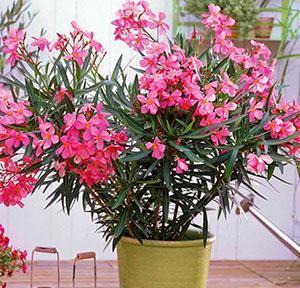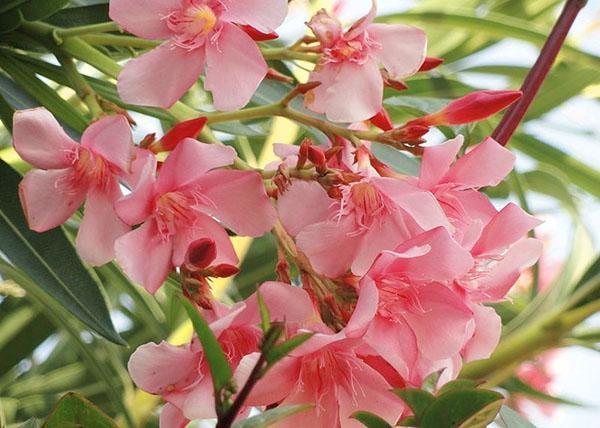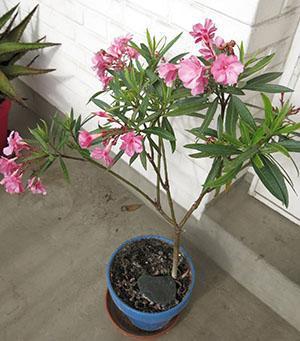Features of oleander care
 Outdoor oleander is a large ornamental shrub with voluminous inflorescences of a variety of colors. In the garden, the cultivation of this crop is practiced in areas with a warm climate, and care for oleander at home is available and can be carried out in any region, but due to the size of the evergreen shrub and its heat-loving nature, it has its own characteristics.
Outdoor oleander is a large ornamental shrub with voluminous inflorescences of a variety of colors. In the garden, the cultivation of this crop is practiced in areas with a warm climate, and care for oleander at home is available and can be carried out in any region, but due to the size of the evergreen shrub and its heat-loving nature, it has its own characteristics.
Oleander gained popularity as an ornamental plant in the Mediterranean countries, in the regions of south-east Asia. In reality and in the photo, oleander flowers amaze with a variety of colors and shapes, and growers who already have experience in growing a plant are well aware of its aroma. Dense leathery leaves of an elongated shape in many cover brownish shoots, and without proper attention, the lower parts of the stems are bare, and the plant tends to grow.

Conditions for growing and caring for oleander
 A shrub that naturally grows in well-lit and ventilated areas requires the same attitude at home. If the oleander pot is in the shade:
A shrub that naturally grows in well-lit and ventilated areas requires the same attitude at home. If the oleander pot is in the shade:
- the leaves will inevitably fade;
- the newly growing foliage becomes smaller;
- inflorescences become sparse and less decorative than usual;
- internodes on new shoots are extended;
- young growth looks noticeably weakened.
 A long stay in the shade threatens with the loss of buds and the refusal of the plant from flowering. In summer, indoor oleander, as in the photo, can be taken out into the garden. At an air temperature of 20-25 ° C, the shrub acclimatizes well and actively develops under the open sky. It is not recommended to plant oleander in the ground in order to avoid the difficulties of transplanting a plant due to the formation of new roots. But digging a container near a garden pond is useful. Moisture helps the bush to withstand the midday sun, even on the hottest summer days. If there is no pond on the site, you can put an ordinary bucket of water nearby. Indoors, the pot is placed in a pallet with wet moss or expanded clay.
A long stay in the shade threatens with the loss of buds and the refusal of the plant from flowering. In summer, indoor oleander, as in the photo, can be taken out into the garden. At an air temperature of 20-25 ° C, the shrub acclimatizes well and actively develops under the open sky. It is not recommended to plant oleander in the ground in order to avoid the difficulties of transplanting a plant due to the formation of new roots. But digging a container near a garden pond is useful. Moisture helps the bush to withstand the midday sun, even on the hottest summer days. If there is no pond on the site, you can put an ordinary bucket of water nearby. Indoors, the pot is placed in a pallet with wet moss or expanded clay.
Oleander is very sensitive to stagnant air, so it is important to ventilate the room often, preventing cold gusts of wind or draft from getting on the plant.
When growing oleander at home, care includes spraying the crown with warm soft water. This measure helps to keep the foliage clean and increase the humidity around the bush.
Seasonal oleander care
The plant reacts better not to frequent moistening of the soil surface, but to more rare but abundant watering, during which water penetrates into the very thickness of the substrate. In the spring and summer, it is necessary to water the oleander more often, which is explained by the needs of the growing bush and more evaporation than in the cold season. The soil is moistened with soft water at room temperature, during this year, preventing the earthen coma with roots from drying out. And from April to the very autumn, watering is combined with top dressing. For these purposes, every two weeks you can use complex fertilizer for flowering crops.
 If in the summer months caring for oleander is not at all laborious and simple, then closer to winter the plant requires special attention.
If in the summer months caring for oleander is not at all laborious and simple, then closer to winter the plant requires special attention.
In nature, the shrub lives in regions where the change of season is quite pronounced. Similar conditions will have to be created when growing and caring for oleander indoors.
First of all, the plant is looking for a place where the bush successfully overwinters at a temperature of 2-12 ° C, being in the light all day. Subzero temperatures and deep shade when caring for oleander at home are strictly contraindicated. If the shrub lacks light, the grower should expect that his green pet will get rid of the foliage, and at the beginning of next summer it will not give the desired inflorescences.
Features of flowering and pruning indoor oleander
Indoor oleander, pictured, is a long-blooming ornamental crop.
If the plant receives enough water, nutrition and care, the flowers open on the shrubs from June to mid-autumn, and often ovaries form on the inflorescence at the same time, and new corollas immediately open.
At home, regular pruning will certainly be included in the care of oleander. The stems are not afraid of strong shortening, dormant axillary buds in the spring will compensate for the loss of the crown, which, thanks to such care, will become much more attractive and thicker.
The optimal time for pruning oleander is autumn, when mass flowering ends. If at home the care for the oleander, in the photo, is done correctly, the plant manages to lay new flower buds by spring and prepare lush fragrant inflorescences for summer. Because of this feature of the shrub, spring pruning is not carried out, with the exception of the sanitary removal of dead, sick or weakened shoots.
 But spring is the best time to transplant the oleander flower shown in the photo.
But spring is the best time to transplant the oleander flower shown in the photo.
Transplantation and reproduction of oleander
 Young bushes can be transferred into new, large pots annually. In this case, the root system is not disturbed, and the voids between the walls of the container and the earthy clod are filled with fresh substrate. It is better to replant adult bushes no more than 1 time in 3-4 years. As a soil for plants, they take a fertile loose mixture from sod land, half the volume of leaf soil, as well as humus and sand. To structure the substrate and as a prophylaxis for bacterial infections, a little crushed charcoal is mixed in.
Young bushes can be transferred into new, large pots annually. In this case, the root system is not disturbed, and the voids between the walls of the container and the earthy clod are filled with fresh substrate. It is better to replant adult bushes no more than 1 time in 3-4 years. As a soil for plants, they take a fertile loose mixture from sod land, half the volume of leaf soil, as well as humus and sand. To structure the substrate and as a prophylaxis for bacterial infections, a little crushed charcoal is mixed in.
When transplanting a large bush, it is sometimes divided, which allows you to quickly multiply the oleander.
But most often this method is not used, but grafting. But before you can propagate oleander, you need to get planting material. To do this, young cuttings are cut from a healthy plant of the variety you like so that they have a growing point and several unfolded green leaves. Harvesting and rooting of seedlings intended for oleander propagation is carried out in summer.
 The lower leaves are removed, and the cuttings are dropped into a wet mixture of sand, perlite and peat. It is better to cover the container with plantings with foil or put in a greenhouse. When 3–5 cm long roots appear on the seedlings, young oleanders are planted in their own pots.
The lower leaves are removed, and the cuttings are dropped into a wet mixture of sand, perlite and peat. It is better to cover the container with plantings with foil or put in a greenhouse. When 3–5 cm long roots appear on the seedlings, young oleanders are planted in their own pots.
 It is even easier and more visual to root the oleander in ordinary water, where you can add crushed charcoal. After transplanting into pots, young plants are easily acclimatized, and next fall they can be carefully trimmed to give rise to a bushy, lush crown.
It is even easier and more visual to root the oleander in ordinary water, where you can add crushed charcoal. After transplanting into pots, young plants are easily acclimatized, and next fall they can be carefully trimmed to give rise to a bushy, lush crown.